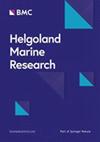Culture of benthic diatom Nitzschia sp. with macroalgae carriers and its application as feed of juveniles Stichopus japonicus
4区 地球科学
Q2 Agricultural and Biological Sciences
引用次数: 1
Abstract
Carrier culture is the combination of suspension culture and adherent culture. Carriers could be used to improve the culture efficiency of large-scale culture of adherent benthic diatom. In order to identify a suitable carrier for mass suspension culture of the benthic diatoms Nitzschia sp. powders of seven macroalgae were used as carriers for diatom attachment including Ulva pertusa, degummed Laminaria japonica, Sargassum muticum, Chaetomorpha valida, Zostera marina, Sargassum fusiforme and Sargassum thunbergii. Diatoms could grow on the surface of the suspended carriers and could effectively utilize the nutrients released by the decomposition of these carriers. Among the seven carriers, Ulva pertusa powder was the most effective for Nitzschia culture when comprehensively considering the nutrition of the harvested diatoms and nutrient utilization of the algae carrier by diatoms. The seaweed powder was dried at 80 °C before used as carrier, this process should meet the sterilization requirements for microalgal culture and is easy to implement in the large-scale cultivation of diatoms. Diatoms cultured with carriers were used to feed juveniles Stichopus japonicus with a wet weight of 5.0 ± 2.0 g, as well as diatoms cultured using conventional methods without carriers, and no significant differences were observed between the two kinds of feed. Compared to sea cucumbers fed with commercial feed, the growth rate of S. japonicus fed with carrier-cultured diatoms was approximately 1.5 times greater, and the activities of non-specific immune enzymes were improved in the coelomic fluid including acidic phosphatase, alkaline phosphatase and superoxide dismutase. Feeding sea cucumber with fresh diatoms could effectively reduce the total nitrogen and total phosphorus in the culture water, improve the water quality, and promote the breeding of sea cucumbers, regardless of whether the carrier culture was adopted.大藻载体底栖硅藻Nitzschia sp.的培养及其在刺参幼鱼饲料中的应用
载体文化是悬浮文化和附着文化的结合。利用载体可提高底栖硅藻大规模培养的效率。为了寻找适合底栖硅藻质量悬浮培养的载体,采用7种大型藻类粉末作为硅藻附着载体,分别为pertusa Ulva、脱胶海带japonica、马尾藻(Sargassum muticum)、Chaetomorpha valida、Zostera marina、fususiforme和thunbergii。硅藻能在悬浮载体表面生长,并能有效利用这些载体分解释放的养分。综合考虑收获硅藻的营养状况和硅藻对藻类载体的养分利用情况,7种载体中,紫花Ulva pertusa粉对Nitzschia培养效果最佳。将海藻粉在80℃下干燥后作为载体,该工艺既满足微藻培养的灭菌要求,又易于在硅藻的大规模培养中实施。将有载体培养的硅藻分别饲喂湿重为5.0±2.0 g的刺参幼鱼和常规无载体培养的硅藻,两种饲料之间无显著差异。与投喂商品饲料的海参相比,投喂载体硅藻的海参生长速度提高了约1.5倍,体腔液中酸性磷酸酶、碱性磷酸酶和超氧化物歧化酶等非特异性免疫酶的活性也有所提高。无论是否采用载体培养,用新鲜硅藻饲喂海参都能有效降低养殖水中的总氮和总磷,改善水质,促进海参的繁殖。
本文章由计算机程序翻译,如有差异,请以英文原文为准。
求助全文
约1分钟内获得全文
求助全文
来源期刊

Helgoland Marine Research
地学-海洋学
自引率
0.00%
发文量
0
审稿时长
6-12 weeks
期刊介绍:
Helgoland Marine Research is an open access, peer reviewed journal, publishing original research as well as reviews on all aspects of marine and brackish water ecosystems, with a focus on how organisms survive in, and interact with, their environment.
The aim of Helgoland Marine Research is to publish work with a regional focus, but with clear global implications, or vice versa; research with global emphasis and regional ramifications. We are particularly interested in contributions that further our general understanding of how marine ecosystems work, and that concentrate on species’ interactions.
 求助内容:
求助内容: 应助结果提醒方式:
应助结果提醒方式:


